CHIPMUNKS
Genus Tamias
FAMILY SCIURIDAE Squirrels & allies
Page two — California chipmunks
|
 There
are 13 chipmunks in California. Ranges and habitats given below are
generalities; see the texts cited for more specifics. Ranges overlap in
numerous locales and some counties may have a half-dozen species
present in a jig-saw puzzle overlay of habitats: There
are 13 chipmunks in California. Ranges and habitats given below are
generalities; see the texts cited for more specifics. Ranges overlap in
numerous locales and some counties may have a half-dozen species
present in a jig-saw puzzle overlay of habitats:
- Alpine Chipmunk T. alpinus alpine zone from Alpine Co. to Tulare Co.
- Yellow-pine Chipmunk T. amoenus
yellow-pine & junipers from Klamath Mts. of northeast California
south along Sierra east slope to Mammoth Lakes [and Cascade & n.
Rocky Mts. north to British Columbia]
- Merriam's Chipmunk T. merriami chaparral and foothill forests from San Mateo Co. and Sierran foothills of Fresno Co. south through Transverse Range
- Least Chipmunk T. minimus sagebrush habitats & adjacent woods east of Sierra [and across Great Basin to edge of Great Plains]
- California Chipmunk T. obscurus
undergrowth scrub of San Bernardino & San Jacinto ranges to Baja
California [Given the limited range I don't like the name "California
Chipmunk," but that is the name settled on by all the primary books
from Wilson & Ruff (1999) to Reid (2006). Nor did I like the name
"Chaparral Chipmunk" used by Jameson & Peeters (1988), as Merriam's
is the real "chaparral" chipmunk. Daniel Williams preferred the English
name "Dusky Chipmunk," which he says is also preferred by the
mammalogist that originally described the species T. obscurus]
- Yellow-cheeked Chipmunk T. ochrogenys
redwoods and madrone forests in narrow coastal zone (only inland 15
miles max) from Eel R. mouth, Humboldt Co. to Bodega Bay, Sonoma Co.
- Panamint Chipmunk T. panamintinus pinyon pines, juniper, and open forests in Panamint & Kingston ranges
- Long-eared Chipmunk T. quadrimaculatus
middle elevation forests (yellow & sugar pine, Douglas fir, Incense
cedar, black oak) in Sierra Nevada from Lake Almanor south through Lake
Tahoe to Bass Lake, Yosemite NP, and along the Carson River in Alpine
Co.
- Allen's (or Shadow) Chipmunk T. senex
humid forests from NW California (Eel & Klamath watershed) across
n. Calif. to Warner Mts. and south in Sierra to Yosemite NP [Jameson
& Peeters (1988) and Bowers et al. (2004) use the name "Shadow
Chipmunk."]
- Siskiyou Chipmunk T. siskiyou spruce, cedar & fir forests of Siskiyou & Klamath ranges
- Sonoma Chipmunk T. sonomae
[inset above right] chaparral, open yellow-pine & oak forests,
mostly inland, from S.F. Bay area north to Salmon Mts., but reaching
the coast in Marin Co.
- Lodgepole Chipmunk T. speciosus
higher elevation forests of lodgepole, whitebark, or Jeffrey pine, or
red fir, in Sierra Nevada (south to Fresno Co.) and isolated higher
peaks in San Bernardino Mts. and on Mt. Pinos
- Uinta Chipmunk T. umbrinus yellow-pine & juniper forests of east slope of southern Sierra [and mountains in Nevada & Utah & Wyoming]
The
identification of some of the more common species were discussed on
page one of this set, so return there if you missed it. The species
covered there were Merriam's, Least, Alpine, Yellow-pine, and Lodgepole
[plus Eastern Chipmunk, which does not occur in California].
Size
and overall color pattern is a good starting point. Of course the first
few chipmunks one sees look "small" so it is initially difficult to
sort out chipmunks by size. But as one gains some experience with a
variety of species the California ones begin falling into recognizable
patterns: the bright little ones (Lodgepole, Yellow-pine), the tiny
gray ones (Least, Alpine) and the larger grayish ones (the "Townsend's"
group that include Allen's, Yellow-cheeked, and Siskiyou). This does
not cover all of them, but is a start. |
|
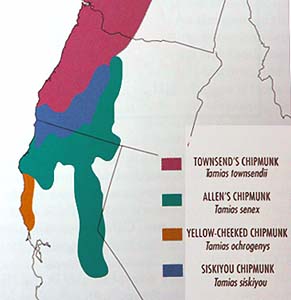 Let's
start on this page with the big dark ones. The split of the Townsend's
Chipmunk complex into four species by Sutton & Nadler (1974) and
Sutton (1987) has now been adopted by all recent authorities. The
splits were based on an analysis of the genital bones (baculum and
baubellum) and genetics, but was also supported on differences in
calls. These chipmunks live in the heavy woods; "Shadow Chipmunk" is an
alternate name for Allen's, but also would have been a good group name. Let's
start on this page with the big dark ones. The split of the Townsend's
Chipmunk complex into four species by Sutton & Nadler (1974) and
Sutton (1987) has now been adopted by all recent authorities. The
splits were based on an analysis of the genital bones (baculum and
baubellum) and genetics, but was also supported on differences in
calls. These chipmunks live in the heavy woods; "Shadow Chipmunk" is an
alternate name for Allen's, but also would have been a good group name.
This range map (right) is from Reid (2006) and
shows a complex distribution in northwestern California and
southwestern Oregon, but otherwise the northernmost one (Townsend's;
see the next page of this web set for a photo) is the only one in most
of western Oregon and on into Washington and B.C. Allen's (or Shadow)
Chipmunk is the only one in the Sierra, but things get complicated
elsewhere. I am not even sure the map is entirely accurate, but I have
learned that what I once thought was "Siskiyou" Chipmunk (photo above)
is actually Allen's Chipmunk, based upon its exact location in Siskiyou
County. |
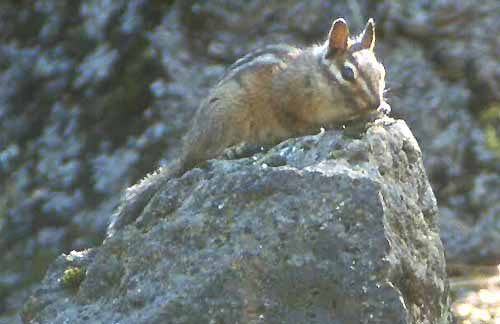 Allen's Chipmunk
(left) is a large grayish chipmunk with a rather wide range from
coastal Humboldt County (between Eel and Klamath Rivers) to well inland
in the mountains; this one was photographed near Lassen Nat'l Park.
Note the subdued patterning and clay-colored sides to a grayish
chipmunk. This is also a large chipmunk, especially when contrasted
with a small chipmunk like the Yellow-pine Chipmunk, a bright-sided
contrasty little beastie that occurs at higher elevations in Lassen
Park. Allen's Chipmunk
(left) is a large grayish chipmunk with a rather wide range from
coastal Humboldt County (between Eel and Klamath Rivers) to well inland
in the mountains; this one was photographed near Lassen Nat'l Park.
Note the subdued patterning and clay-colored sides to a grayish
chipmunk. This is also a large chipmunk, especially when contrasted
with a small chipmunk like the Yellow-pine Chipmunk, a bright-sided
contrasty little beastie that occurs at higher elevations in Lassen
Park.
Siskiyou Chipmunk, north of the Klamath
River, has a one syllable call that starts at low pitch, rises, and
than falls again (looked like an inverted chevron on a sonogram).
Yellow-cheeked has a distinctive low-pitched two-or-three syllable
"chip-chip" or "chip-chip-chip" pattern. I was just learning about
these points in summer 2001 when Rita and I visited Van Damme State
Park in Mendocino Co., California. While walking the Fern Canyon trail
in a lush wet coastal forest we heard a "chip-chip-chip" sequence
numerous times from well up on the mossy limbs of a Bigleaf Maple. I
passed it off as a squirrel call but Rita insisted I track it down. It
turned out to be my lifer Yellow-cheeked Chipmunk (both photos below). |
|
| Note
that Yellow-cheeked Chipmunk is also a dark and dingy beast. Indeed,
only its central stripe was very apparent on the body. The facial
stripes were well-marked, though, and there was a big white patch
behind the ears. Note also the bicolored pattern on the back of the
ears: dark in front and white behind. The other chipmunk in range here
(but usually more inland) is Sonoma Chipmunk which is much redder and
has unicolored backs of its ears in summer (but not winter) pelage. I
was quite impressed to learn that, like birds, state of plumage (er,
pelage) and molt can be important to field identification and that
vocalizations can be distinctive and useful! |
|
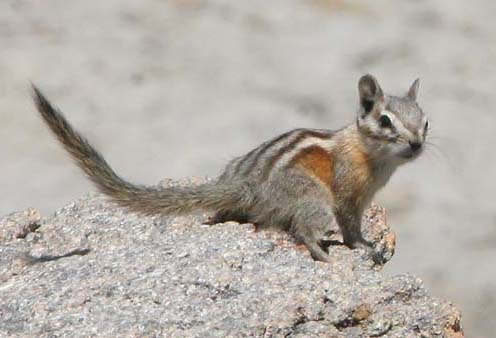 Turning our attention to some brighter chipmunks of more open forests, we were delighted to find multiple broods of Panamint Chipmunk
(above, with Mountain Quail) on a hill with an open Jeffrey Pine forest
(recently burned) and rocky outcrops in Mono County. It is a bright,
contrasty, gray-rumped chipmunk. The center pale stripes are gray; the
outermost pale stripe is white. The field guides contradict each other
as to whether the dark outermost stripe should be apparent (Reid says
no, photos in Bowers et al. say yes). That stripe is apparent in these
photos. Turning our attention to some brighter chipmunks of more open forests, we were delighted to find multiple broods of Panamint Chipmunk
(above, with Mountain Quail) on a hill with an open Jeffrey Pine forest
(recently burned) and rocky outcrops in Mono County. It is a bright,
contrasty, gray-rumped chipmunk. The center pale stripes are gray; the
outermost pale stripe is white. The field guides contradict each other
as to whether the dark outermost stripe should be apparent (Reid says
no, photos in Bowers et al. say yes). That stripe is apparent in these
photos.
I think Panamint (left & below left) is similar to Yellow-pine
(below right): both have dark outermost stripes and bright orange
sides. Note small differences in ear shape and muzzle shape, but
Yellow-pine is overall a brighter chipmunk, and the orangey color of
the sides washes forward into the cheeks (below right). On Panamint
(below left and fullscale photo below that), the cheeks are white —
indeed, the entire face is more white with broader white stripes both
above and below the eye. [I have yet to see Uinta Chipmunk, which is
similar but overall darker]. |
|
|
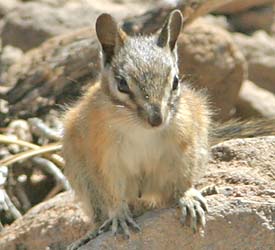 In
the end, the key piece of information to identify these Panamint
Chipmunks (above) was the latitude-longitude of the location, which
exactly matched the spot where specimens of T. panamintinus were collected and deposited at the Museum of Vertebrate Zoology, U.C. Berkeley. In
the end, the key piece of information to identify these Panamint
Chipmunks (above) was the latitude-longitude of the location, which
exactly matched the spot where specimens of T. panamintinus were collected and deposited at the Museum of Vertebrate Zoology, U.C. Berkeley.
This chipmunk (left) may be Long-eared Chipmunk.
It is also a bright and contrasty species, and the photo does show
rather largish ears. However, the photo angle does not permit
inspection of the area behind the ears, where Long-eared has a large
white patch. The location is within a couple miles of where a large
collection of T. quadrimaculatus was taken; those specimens now reside at MVZ. |
| Despite
these web pages, there are still chipmunks that I can't identify for
sure, and I still have unlabeled photos in my files. I guess that the
bottom line on chipmunks is: when in doubt, check the bacula! |
|
PHOTOS: The inset Sonoma Chipmunk Tamias sonomae was at Plaskett Meadow, Glenn Co., California, on 18 June 2006. The first Allen's Chipmunk T. sinex was along Gumboot Creek in extreme western Siskiyou Co., California, on 22 July 2007; the second Allen's Chipmunk T. senex was at Battle Creek campground near Lassen Nat'l Park, Tehama Co., California, 15 August 2001. The Yellow-cheeked Chipmunk T. ochrogenys was in Van Damme State Park, Mendocino Co., California, 30 June 2001. The brood of Panamint Chipmunk T. panamintinus was along Hwy 395, just north of June Lake Junction, Mono Co., California, on 13 August 2009. The Yellow-pine was at Willow Lake, Plumas Co., California, on 23 July 2007. The Long-eared Chipmunk T. quadrimaculatus was at Curtz Lake, Alpine Co., California, on 15 August 2006. All photos © Don Roberson, all rights reserved.
Literature cited:
Bowers, N., R. Bowers, and K. Kaufman. 2004. Mammals of North America. Kaufman Focus Guide. Houghton Mifflin, Boston.
Harris, J. H. 1982. Mammals of the Mono Lake-Tioga Pass Region. Kutsavi Books, Lee Vining, CA.
Hartson, T. 1999. Squirrels of the West. Lone Pine Field Guide. Lone Pine Publ., Edmonton, AB.
Ingles, L. G. 1965. Mammals of the Pacific States. Stanford Univ. Press, Stanford, CA.
Jameson, E. W., Jr., and H. J. Peeters. 1988. California Mammals. Univ. of Calif. Press, Berkeley.
Johnson, D. H. 1943. Systematic review of the chipmunks (genus Eutamias) of California. Univ. Cal. Publ. Zool. 48: 63-148.
Laudenslayer, W. F., Jr. 1991. A check-list of the amphibians,
reptiles, birds, and mammals of California. Calif. Fish & Game 77:
109-141.
Reid, F.A. 2006. Mammals of North America. Peterson Field Guides. Houghton Mifflin, Boston.
Sutton,
D. A. 1962. "Chromosomes of some Sciuridae," abstract of paper given
before the Western Society of Naturalists, San Jose, CA, cited in
Ingles (1965).
Sutton, D. A. 1987. Analysis of Pacific coast Townsend's Chipmunks (Rodentia: Sciuridae). Southwestern Naturalist 32: 371-376.
Sutton, D. A., and C. F. Nadler. 1974. Systematic revision of three Townsend's Chipmunks (Eutamias townsendii). Southwestern Naturalist 19: 199-211.
Wilson, D. E., and S. Ruff. 1999. The Smithsonian Book of North American Mammals. Smithsonian Instit. Press, Washington, D. C.
|
TOP
Page created 7-23 June 2001, revised and expanded 6-20 July 2008, revised again 18 Aug 2009 |
|
 There
are 13 chipmunks in California. Ranges and habitats given below are
generalities; see the texts cited for more specifics. Ranges overlap in
numerous locales and some counties may have a half-dozen species
present in a jig-saw puzzle overlay of habitats:
There
are 13 chipmunks in California. Ranges and habitats given below are
generalities; see the texts cited for more specifics. Ranges overlap in
numerous locales and some counties may have a half-dozen species
present in a jig-saw puzzle overlay of habitats: 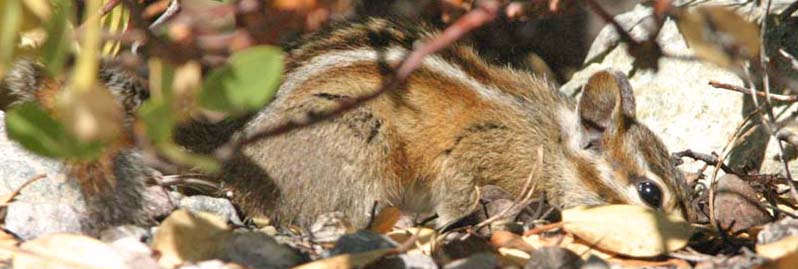
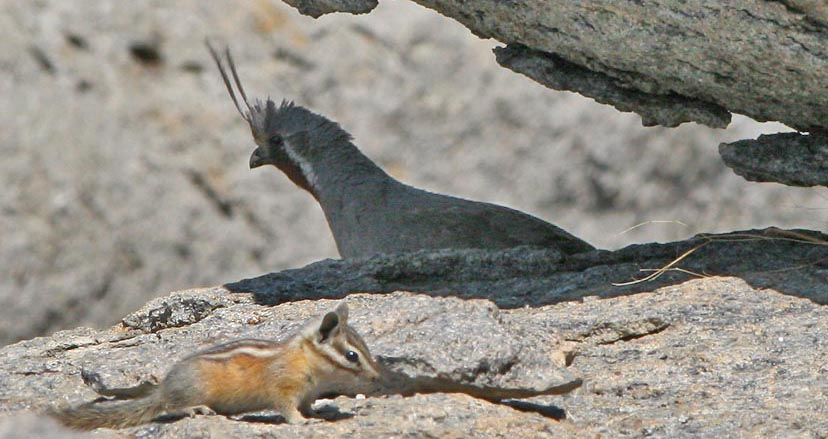
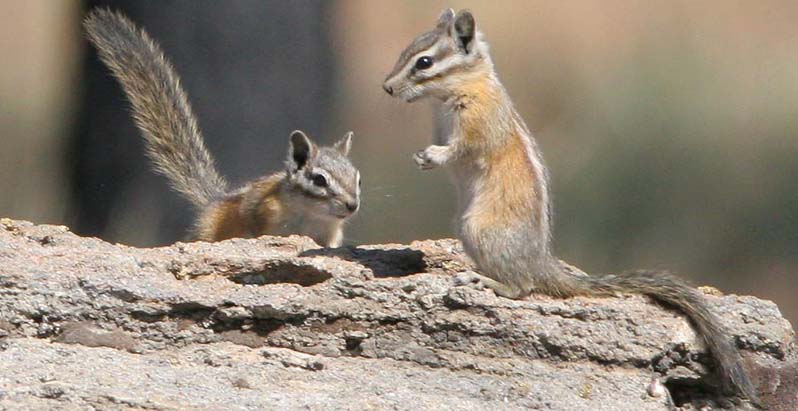
 Let's
start on this page with the big dark ones. The split of the Townsend's
Chipmunk complex into four species by Sutton & Nadler (1974) and
Sutton (1987) has now been adopted by all recent authorities. The
splits were based on an analysis of the genital bones (baculum and
baubellum) and genetics, but was also supported on differences in
calls. These chipmunks live in the heavy woods; "Shadow Chipmunk" is an
alternate name for Allen's, but also would have been a good group name.
Let's
start on this page with the big dark ones. The split of the Townsend's
Chipmunk complex into four species by Sutton & Nadler (1974) and
Sutton (1987) has now been adopted by all recent authorities. The
splits were based on an analysis of the genital bones (baculum and
baubellum) and genetics, but was also supported on differences in
calls. These chipmunks live in the heavy woods; "Shadow Chipmunk" is an
alternate name for Allen's, but also would have been a good group name.
 Allen's Chipmunk
(left) is a large grayish chipmunk with a rather wide range from
coastal Humboldt County (between Eel and Klamath Rivers) to well inland
in the mountains; this one was photographed near Lassen Nat'l Park.
Note the subdued patterning and clay-colored sides to a grayish
chipmunk. This is also a large chipmunk, especially when contrasted
with a small chipmunk like the Yellow-pine Chipmunk, a bright-sided
contrasty little beastie that occurs at higher elevations in Lassen
Park.
Allen's Chipmunk
(left) is a large grayish chipmunk with a rather wide range from
coastal Humboldt County (between Eel and Klamath Rivers) to well inland
in the mountains; this one was photographed near Lassen Nat'l Park.
Note the subdued patterning and clay-colored sides to a grayish
chipmunk. This is also a large chipmunk, especially when contrasted
with a small chipmunk like the Yellow-pine Chipmunk, a bright-sided
contrasty little beastie that occurs at higher elevations in Lassen
Park.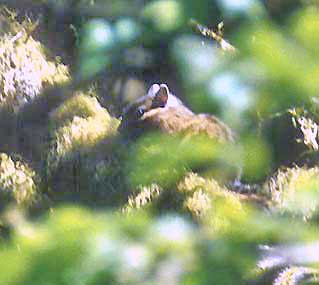
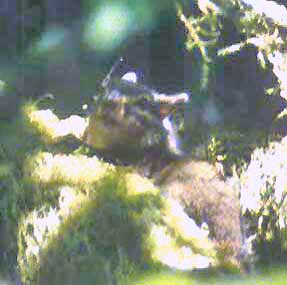
 Turning our attention to some brighter chipmunks of more open forests, we were delighted to find multiple broods of Panamint Chipmunk
(above, with Mountain Quail) on a hill with an open Jeffrey Pine forest
(recently burned) and rocky outcrops in Mono County. It is a bright,
contrasty, gray-rumped chipmunk. The center pale stripes are gray; the
outermost pale stripe is white. The field guides contradict each other
as to whether the dark outermost stripe should be apparent (Reid says
no, photos in Bowers et al. say yes). That stripe is apparent in these
photos.
Turning our attention to some brighter chipmunks of more open forests, we were delighted to find multiple broods of Panamint Chipmunk
(above, with Mountain Quail) on a hill with an open Jeffrey Pine forest
(recently burned) and rocky outcrops in Mono County. It is a bright,
contrasty, gray-rumped chipmunk. The center pale stripes are gray; the
outermost pale stripe is white. The field guides contradict each other
as to whether the dark outermost stripe should be apparent (Reid says
no, photos in Bowers et al. say yes). That stripe is apparent in these
photos. 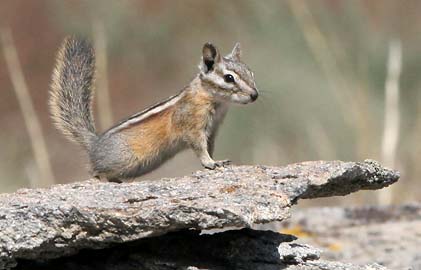
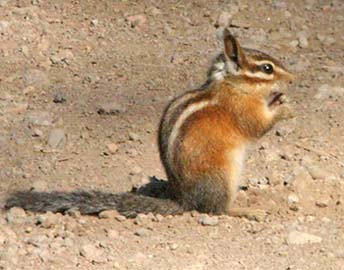
 In
the end, the key piece of information to identify these Panamint
Chipmunks (above) was the latitude-longitude of the location, which
exactly matched the spot where specimens of T. panamintinus were collected and deposited at the Museum of Vertebrate Zoology, U.C. Berkeley.
In
the end, the key piece of information to identify these Panamint
Chipmunks (above) was the latitude-longitude of the location, which
exactly matched the spot where specimens of T. panamintinus were collected and deposited at the Museum of Vertebrate Zoology, U.C. Berkeley.